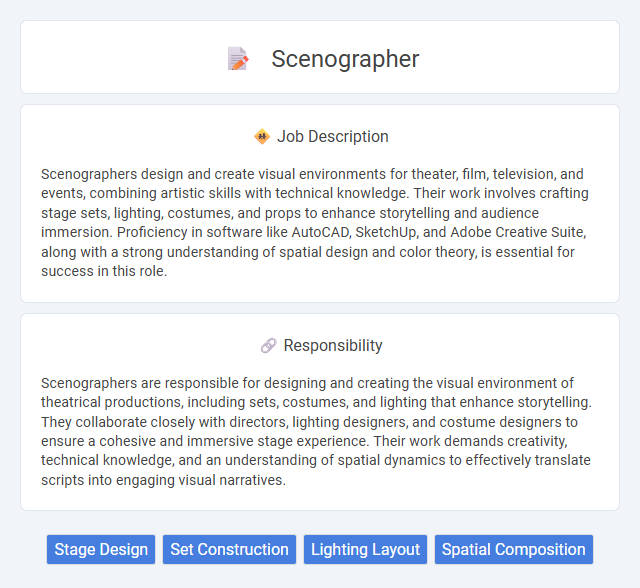
Scenographers design and create visual environments for theater, film, television, and events, combining artistic skills with technical knowledge. Their work involves crafting stage sets, lighting, costumes, and props to enhance storytelling and audience immersion. Proficiency in software like AutoCAD, SketchUp, and Adobe Creative Suite, along with a strong understanding of spatial design and color theory, is essential for success in this role.
Individuals with a strong creative vision and an eye for detail are likely to thrive as scenographers, as the job requires designing and organizing stage settings that enhance storytelling. Those comfortable working in collaborative environments and handling the physical demands of set construction may find this career suitable. People who enjoy combining artistic skills with technical knowledge probably have a higher chance of success in this dynamic and challenging field.
Qualification
A scenographer typically requires a bachelor's degree in theater design, fine arts, or a related field, with specialized training in set design, lighting, and costume coordination. Proficiency in digital design software such as AutoCAD, SketchUp, or Adobe Creative Suite enhances the ability to visualize and implement creative concepts. Practical experience through internships or theater productions is essential to develop a strong portfolio demonstrating versatility and innovation in stage environment creation.
Responsibility
Scenographers are responsible for designing and creating the visual environment of theatrical productions, including sets, costumes, and lighting that enhance storytelling. They collaborate closely with directors, lighting designers, and costume designers to ensure a cohesive and immersive stage experience. Their work demands creativity, technical knowledge, and an understanding of spatial dynamics to effectively translate scripts into engaging visual narratives.
Benefit
A scenographer likely enhances storytelling by creating immersive visual environments that captivate audiences, increasing overall production value. Their expertise in blending lighting, set design, and costume elements can significantly improve the mood and atmosphere of a performance. Hiring a skilled scenographer probably leads to more engaging and memorable theatrical experiences.
Challenge
A scenographer's job probably involves significant creative and technical challenges, requiring a deep understanding of spatial design and storytelling. They must likely balance artistic vision with practical constraints such as budget, materials, and stage limitations. Problem-solving skills are often essential to transform abstract concepts into immersive environments that enhance the audience's experience.
Career Advancement
A scenographer designs visual environments for theater, film, and events, specializing in set, lighting, and costume design to enhance storytelling. Career advancement involves gaining experience in diverse productions, mastering digital design tools, and building a strong portfolio that attracts collaborations with renowned directors and production companies. Leadership roles such as lead scenographer or creative director often follow as professionals demonstrate expertise in innovative aesthetics and project management.
Key Terms
Stage Design
Scenographers specializing in stage design create immersive environments that enhance theatrical performances through innovative use of space, lighting, and materials. They collaborate closely with directors and production teams to develop visual concepts that support the narrative and emotional tone of the play. Mastery of software such as AutoCAD and SketchUp is essential for precise planning and execution of stage layouts.
Set Construction
Scenographers specializing in set construction design and build physical environments for theater, film, and television productions, ensuring that every element supports the director's vision and enhances storytelling. They collaborate with carpenters, painters, and technical teams to create safe, functional, and visually compelling sets using materials such as wood, metal, and fabrics. Mastery of spatial design, structural integrity, and material properties is essential to bring immersive, realistic scenes to life on stage or screen.
Lighting Layout
A scenographer specializing in lighting layout designs precise lighting plans that enhance the mood, depth, and visibility on stage. This role requires expertise in light positioning, color theory, and the use of advanced lighting technology to create impactful visual effects. Effective lighting layouts ensure seamless integration with set design and choreography, elevating the overall theatrical experience.
Spatial Composition
Scenographers specialize in spatial composition by designing and organizing physical environments for theatrical, film, and event productions to enhance narrative storytelling. Their expertise involves manipulating space, materials, and lighting to create immersive atmospheres that support character movement and audience engagement. Mastery of spatial dynamics ensures the seamless integration of artistic vision with functional stage requirements.
 kuljobs.com
kuljobs.com